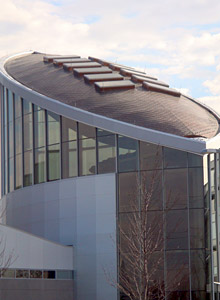Copper Joins the Huddle
Kansas City Chiefs' new training facility showcases a copper football-shaped roof
The Kansas City Chiefs are known for their hard-hitting on the gridiron. But since 2009, the team has been creating some buzz off of it because of their practice facility's innovative architectural design. The Chiefs' new home in Kansas City, Missouri has an interesting oblong shape that resembles a pigskin, a likeness reinforced by the large copper football that covers the top of the training facility.
The 3,500-square-foot copper covering has six sets of skylights, reminiscent of a football's laces, and sits atop the facility's three story atrium. James Spann, project manager at A2MG, Inc., the company that fabricated and installed the Chief's jaw-dropping copper rooftop football, said that copper's ease of use and durability made it the best choice for the project.
"Copper was easy to work with on a good design like this," said Spann. "It allowed us to easily solder around the skylights to avoid common leaking issues."
The training facility houses the team's offices, meeting rooms, a dining area, and most importantly, locker and equipment rooms. While copper played a major role in the facility's innovative design, had it also been applied to the touch surfaces inside the building it could have aided in killing bacteria*.
Laboratory testing has shown that antimicrobial copper kills greater than 99.9 percent of bacteria* within two hours. Clinical trials being conducted at three U.S. hospitals reveal that ICU rooms that had stainless steel and plastic surfaces replaced with copper harbored significantly less bacteria, including Methicillin-resistant Staphylococcus aureus, commonly referred to as MRSA, VRE and E. coli.
The laboratory and clinical trial findings have implications for the sports world, where MRSA infections are not uncommon, particularly in the NFL. Several high-profile athletes including Kellen Winslow Jr., then a Cleveland Brown and now a Tampa Bay Buccaneer, contracted a staph infection previously. In 2003, five St. Louis Rams players fought MRSA infections on eight different occasions.
Locker rooms are notorious breeding grounds for bacteria, but if antimicrobial copper was used for common surfaces ─ doorknobs, faucets, showerheads, benches and athletic training tables, the amount of lurking bacteria* would be decreased.
Safety is always a priority when it comes to athletics; both on and off the field. Using copper in the locker room, where athletes change, store their equipment, and often tend to minor wounds, may greatly benefit the athletes. Avoiding infections is critical to the staff and to the owners, who have a financial investment in the team that they run out to the field every Sunday.
In future arenas and stadiums, copper could end up being just as influential behind the scenes as it is in the stunning architecture that greets the Kansas City Chief fans.
* Laboratory testing shows that, when cleaned regularly, Antimicrobial Copper alloys kill greater than 99.9% of the following bacteria within 2 hours of exposure: MRSA, Vancomycin-ResistantEnterococcus faecalis (VRE), Staphylococcus aureus, Enterobacter aerogenes, Pseudomonas aeruginosa, and E. coli O157:H7. Antimicrobial Copper surfaces are a supplement to and not a substitute for standard infection control practices and have been shown to reduce microbial contamination, but do not necessarily prevent cross contamination; users must continue to follow all current infection control practices. Cu
Also in this Issue:
- Habitat for Humanity Goes Green
- Alternative Joining Systems Meet the Challenge
- Feel the Breeze
- Copper Joins the Huddle
- Solar Systems Use Copper to Harness Sun's Energy

 Provided by James Spann, Project Manager, A2MG Inc.
Provided by James Spann, Project Manager, A2MG Inc.